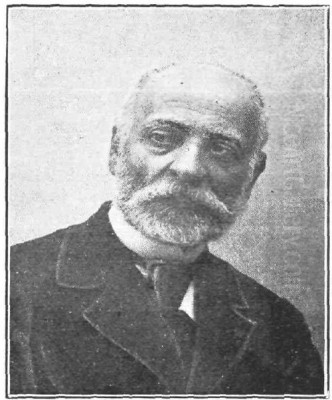
Constantinos Volanakis stands as a monumental figure in the history of Greek art, celebrated primarily as the "Father of Greek Seascape Painting." His life and work are intrinsically linked to the maritime world, capturing the essence of the Greek relationship with the sea through canvases filled with light, atmosphere, and meticulous detail. Born during a period of national consolidation and cultural renaissance in Greece, Volanakis navigated the currents of European artistic trends while forging a distinctly Hellenic vision, leaving behind a legacy that continues to resonate deeply within Greek culture and the broader world of art history. His dedication to the marine genre, at a time when academic tastes often favoured historical or portrait painting, marked him as a pioneer whose influence shaped generations of artists.
Early Life and Artistic Awakening
Constantinos Volanakis was born in Heraklion, on the island of Crete, in 1837. Crete was then still under Ottoman rule, a fact that subtly underscores the backdrop of national aspiration against which much 19th-century Greek art developed. His family later moved to the island of Syros, a burgeoning commercial and maritime centre in the Aegean Sea. This early exposure to the vibrant life of Greek ports undoubtedly planted the seeds for his future artistic focus. His family, however, initially steered him towards a more conventional career path.
Following the completion of his basic education in Syros, Volanakis was sent to Trieste, then a major port of the Austro-Hungarian Empire with a significant Greek merchant community. There, he worked as an accountant for the Greek sugar merchant P. Afentoulis, whose family were relatives. It was during this period, amidst ledgers and accounts, that Volanakis's innate artistic talent began to surface irrepressibly. He started sketching the ships and harbour scenes he observed daily, reportedly filling the margins and even the pages of his accounting books with his drawings.
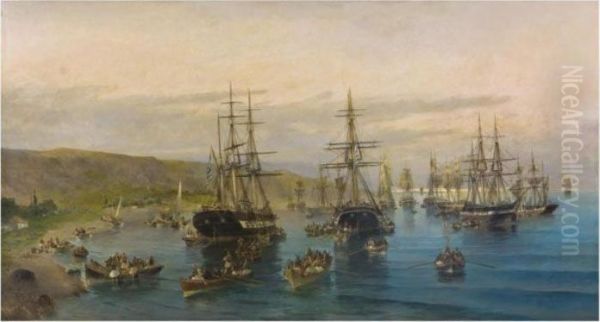
The story goes that his employer, upon discovering these sketches, recognized the young man's true calling. Instead of reprimanding him, Afentoulis was impressed by the quality and passion evident in the drawings. Recognizing Volanakis's potential, he made the pivotal decision to support his artistic education, persuading Volanakis's family and providing the financial means for him to pursue formal art training. This act of patronage was crucial, redirecting Volanakis from a life in commerce to one dedicated entirely to art.
The Munich Years: Forging a Path
In 1864 or 1865, armed with the support of his benefactor, Constantinos Volanakis travelled to Munich, a major centre for art education in Europe at the time. He enrolled in the prestigious Royal Academy of Fine Arts (Akademie der Bildenden Künste München). This institution was a hub for the so-called "Munich School," a style characterized by academic realism, often focusing on historical subjects, portraiture, and genre scenes, rendered with dark palettes and dramatic chiaroscuro.
At the Academy, Volanakis became a student of Karl von Piloty, one of the leading figures of the Munich School, renowned for his large-scale historical paintings. Studying under Piloty provided Volanakis with a strong foundation in academic drawing and composition. However, despite the prevailing emphasis on historical and figure painting within Piloty's circle and the Academy at large, Volanakis remained steadfastly drawn to landscape, and specifically, seascape painting.
His passion for the sea, nurtured during his youth in Syros and Trieste, found fertile ground even in landlocked Munich. He dedicated himself to mastering the depiction of water, ships, and coastal atmospheres. While absorbing the technical rigour of the Munich School, Volanakis began to look towards other influences more aligned with his chosen genre. He studied the works of the Dutch Golden Age marine painters, such as Willem van de Velde the Younger, admiring their detailed realism and atmospheric sensitivity. He was also likely aware of German Romantic landscape traditions, perhaps finding resonance in the emotional depth conveyed by artists like Caspar David Friedrich, although Dutch realism seems a more direct stylistic antecedent for his detailed approach.
Breakthrough: The Battle of Lissa
A significant turning point in Volanakis's career came in 1869. Following the naval Battle of Lissa (1866), fought between the Austrian Empire and the Kingdom of Italy during the Austro-Prussian War, Emperor Franz Joseph I of Austria announced an art competition. Artists were invited to submit paintings depicting the Austrian naval victory. Volanakis, still a student in Munich, decided to enter.
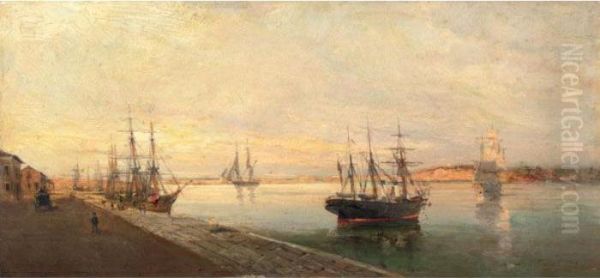
His resulting painting, The Battle of Lissa, was a triumph. It captured the drama and chaos of the naval engagement with remarkable skill and accuracy, showcasing his mastery in rendering ships, smoke, and the turbulent sea. The Emperor himself was deeply impressed by Volanakis's depiction. The painting won the competition, earning Volanakis not only considerable recognition but also a substantial prize of 1000 gold florins.
Furthermore, the prize included the privilege of free travel on the steamships of the Austrian Lloyd company for three years. This enabled Volanakis to travel extensively, observe different maritime environments, and gather material for his future work. The award-winning painting, The Battle of Lissa, was acquired for the Imperial collection and eventually found its home in the Museum of Fine Arts in Budapest, cementing Volanakis's reputation beyond the confines of the Academy. This success validated his focus on marine subjects and significantly boosted his early career.
Artistic Style and Dominant Themes
Constantinos Volanakis developed a distinctive style that blended the meticulous realism learned in Munich with a palpable romantic sensibility. His primary subject was always the sea, in all its manifestations: calm harbours bathed in moonlight, bustling ports alive with commercial activity, fishing boats setting out at dawn or returning at sunset, and dramatic naval battles echoing Greece's history and contemporary events.
His realism was evident in the extraordinary attention to detail, particularly in the rendering of ships. Volanakis possessed an intimate knowledge of naval architecture, meticulously depicting the rigging, hulls, and sails of various vessels, from small fishing caiques to large frigates and steamships. This accuracy extended to his portrayal of water, capturing the texture of waves, the play of light on the surface, and the subtle reflections. His skies are equally convincing, conveying different times of day and weather conditions with atmospheric truth.
However, Volanakis was more than just a precise recorder of maritime scenes. His work is imbued with emotion and a sense of poetry. He masterfully used light and colour to create mood. Sunrises and sunsets often feature warm, golden hues, evoking tranquility or nostalgia. Moonlit scenes possess a serene, almost mystical quality, with silvery light casting long shadows across the water. In his battle scenes, the drama is heightened by dynamic compositions, the contrast of light and shadow, and the depiction of smoke and fire against the vastness of the sea.
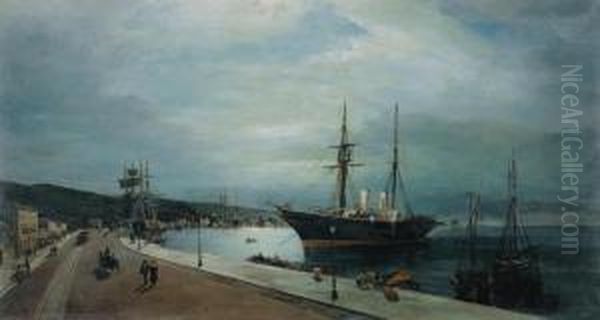
While influenced by the Dutch masters in his detail and the Munich School in his technical grounding, Volanakis's style also shows an awareness of later trends. Some works, particularly from the 1870s onwards, exhibit a lighter palette and a freer brushstroke, suggesting an engagement with the plein-air principles of the Barbizon School and the atmospheric concerns of early Impressionism, though he never fully adopted Impressionist techniques of broken colour. His approach remained rooted in representational accuracy, but with an increasing emphasis on capturing the fleeting effects of light and atmosphere, lending his work a unique blend of realism and lyricism.
Representative Masterpieces
Volanakis's oeuvre is rich with memorable works that exemplify his skill and thematic concerns. Beyond the pivotal Battle of Lissa, several other paintings stand out:
The Burning of the Turkish Frigate at Eressos: This painting depicts a dramatic episode from the Greek War of Independence (1821-1829). Rather than focusing solely on the heat of battle, Volanakis often highlighted the symbolic power of the event, concentrating on the majestic ship engulfed in flames against a dark sea and sky. It’s a powerful image of defiance and sacrifice, central themes in 19th-century Greek historical consciousness.
The Arrival of Karaiskakis at Faliro: Another historical subject, this work portrays Georgios Karaiskakis, a hero of the Greek Revolution, landing with his troops near Athens. Volanakis combines historical narrative with his characteristic marine setting, depicting the ships and the coastal landscape with his usual care, grounding the historical event in a tangible, atmospheric reality.
Harbour Scenes (Piraeus, Volos, etc.): Volanakis painted numerous views of Greek harbours, particularly Piraeus, the main port of Athens where he eventually settled. These works capture the daily life of the ports – ships docking, goods being loaded, fishermen tending their nets. Paintings like The Port of Volos or Moonlit Harbour of Volos are celebrated for their tranquil beauty and masterful handling of light, showcasing a more peaceful aspect of the maritime world.
Fishing Boats and Coastal Views: Alongside grand historical scenes and bustling ports, Volanakis created many intimate depictions of fishing boats and coastal life. Works like Fishing Boats at Sunset or The Fisherman's Home on the Beach convey a deep empathy for the lives of ordinary seafarers and the simple beauty of the Greek coastline. These paintings often feature stunning light effects and a palpable sense of place.
These examples illustrate the breadth of Volanakis's engagement with his chosen subject, moving seamlessly between historical drama, documentary observation, and poetic interpretation of the sea and the lives connected to it.
Return to Greece and Teaching Career
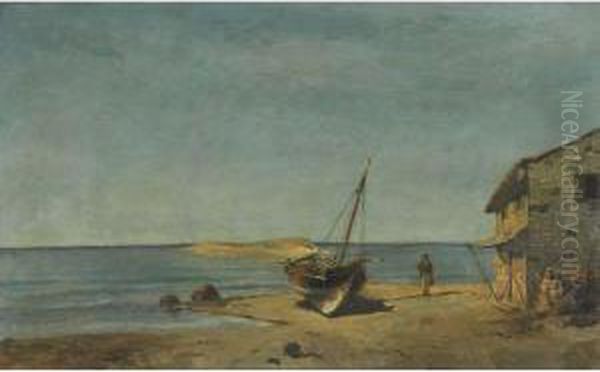
Despite his success and established reputation in Munich, Volanakis faced challenges. The demand for seascape painting, while appreciated by some patrons like Emperor Franz Joseph I, was perhaps not as commercially robust as that for the historical and genre scenes favoured by the mainstream Munich School. Financial difficulties may have played a role in his decision to eventually leave Germany.
In 1883, citing his wife's health concerns, Constantinos Volanakis returned to Greece with his family and settled in Piraeus. Soon after his return, he was appointed Professor at the Athens School of Fine Arts (precursor to the Athens School of Fine Arts). Sources suggest he may have taken over a chair related to elementary painting or drawing. This position provided some financial stability, although academic salaries were notoriously low.
His presence at the School of Fine Arts was significant. He brought his extensive European training and his specialized focus on seascape painting back to his homeland. However, the Athenian art scene at the time was still heavily dominated by the academic traditions of the Munich School, primarily through the influence of established figures like Nikiforos Lytras and Nikolaos Gysis, who focused more on genre scenes, portraits, and historical allegories reflecting national ideals. Volanakis's dedication to landscape and seascape was somewhat outside this mainstream.
Due to the limited appreciation for his genre within the official structures and perhaps his own financial needs, Volanakis also opened a private art school in Piraeus. Here, he could teach according to his own principles and attract students specifically interested in marine painting. He became an influential teacher, nurturing the talents of several artists who would carry on the tradition of Greek seascape painting. Among his notable students were Vasileios Hatzis, Michalis Oikonomou, and Nikolaos Vokos. His teaching emphasized direct observation, technical skill, and capturing the unique light and atmosphere of the Greek sea.
Contemporaries and the Greek Art Scene
Constantinos Volanakis operated within a vibrant and evolving Greek art world during the latter half of the 19th century. His career overlapped with several key figures who shaped modern Greek art, many of whom were also trained in Munich. Understanding his place requires acknowledging these contemporaries.
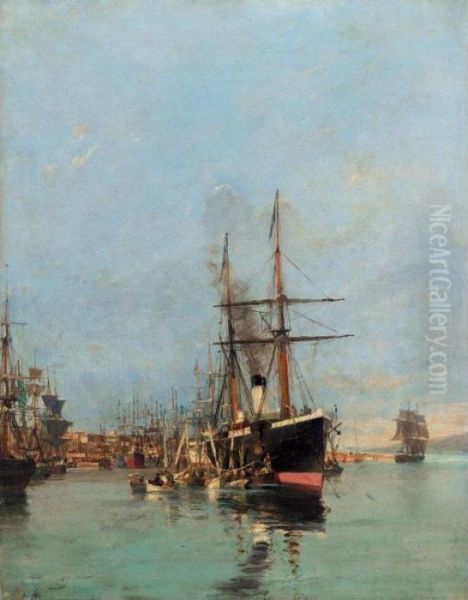
The dominant figures associated with the Munich School in Greece were Nikiforos Lytras (1832-1904) and Nikolaos Gysis (1842-1901). Lytras was known for his ethnographic genre scenes depicting Greek customs and family life, while Gysis excelled in allegorical and historical compositions, as well as sensitive genre paintings. Georgios Iakovidis (1853-1932), another Munich-trained artist, specialized in tender portrayals of children and family life. While Volanakis shared their academic grounding, his thematic focus set him apart. Theodoros Vryzakis (1814-1878), an earlier pioneer of the Munich School in Greece, had established a tradition of historical painting focused on the War of Independence, a theme Volanakis occasionally touched upon but from a distinctly maritime perspective.
In the specific field of seascape painting, Volanakis's most significant contemporary was Ioannis Altamouras (1852-1878). Altamouras, who studied in Copenhagen, was a highly talented marine painter, also known for dramatic depictions of naval battles from the War of Independence. His tragically early death from tuberculosis cut short a promising career, leaving Volanakis as the undisputed master of the genre in Greece for decades.
Other artists active during or slightly after Volanakis's time include Symeon Savvidis (1859-1927), also Munich-trained, known for genre scenes but also some landscapes and seascapes, and Dionysios Tsokos (1820-1862), an earlier painter from the Ionian School tradition who also depicted historical scenes. Later artists clearly influenced by Volanakis include his students Vasileios Hatzis (1870-1915), who became a renowned seascape painter in his own right, Ioannis Koutsis (1860-1953), known for his atmospheric harbour scenes, and Nikos Kalogeropoulos (1889-1957), who continued the tradition into the 20th century, sometimes incorporating Impressionistic touches. Even artists with different primary focuses, like Spyros Papaloukas (1892-1957), a major figure of 20th-century Greek modernism known for landscapes and religious art, operated within an artistic lineage shaped by pioneers like Volanakis.
Later Life and Enduring Challenges
Despite his professorship and the high regard for his artistic skill, Volanakis's later life in Greece was marked by persistent financial struggles. The market for art in Athens was limited, and tastes, as mentioned, often favoured other genres over seascapes. There are anecdotes suggesting that Volanakis, despite his fame, sometimes had to barter his paintings for basic necessities, such as groceries from a local shop in Piraeus.
This situation reflects not only the economic realities of Greece at the time but also a certain lag in the appreciation of landscape and seascape painting as major genres compared to the more established historical and figurative traditions. While recognized as a master, he did not achieve the level of financial security that might have been expected given his talent and reputation.
His health also reportedly declined in his later years. Nevertheless, he continued to paint prolifically, driven by his unwavering passion for the sea. He remained based in Piraeus, the port city providing him with constant inspiration right outside his doorstep. Constantinos Volanakis died in Piraeus on June 29, 1907, at the age of 70, leaving behind a vast body of work dedicated almost entirely to the Greek maritime world.
Legacy and Historical Significance
Constantinos Volanakis's legacy is immense and multifaceted. He is unequivocally recognized as the preeminent figure in Greek seascape painting, earning his title as its "Father." His work fundamentally shaped the direction of this genre within Greek art, establishing a high standard of technical excellence, observational accuracy, and emotional depth.
His influence extended through his teaching, fostering a lineage of marine painters who continued to explore the themes he pioneered. Artists like Vasileios Hatzis directly carried his mantle, while others absorbed his influence more broadly. He demonstrated that the Greek sea was not just a backdrop but a worthy subject in its own right, capable of conveying national identity, historical memory, and profound aesthetic experiences.
Today, Volanakis's paintings are highly sought after by collectors and are prominent features in major Greek museums, including the National Gallery–Alexandros Soutzos Museum in Athens, the Averoff Gallery in Metsovo, and numerous private collections. His works command high prices at auction, reflecting his established importance in the canon of Greek art.
His international recognition, initiated by the Battle of Lissa prize, continued throughout his life with participation in exhibitions abroad, including winning a silver medal at the Exposition Universelle in Paris in 1903. Recent exhibitions dedicated to his work, such as those organized by institutions like the B. & M. Theocharakis Foundation for the Fine Arts and Music, continue to celebrate his contribution and introduce his art to new audiences, reaffirming his status as a master.
Ultimately, Constantinos Volanakis did more than just paint the sea; he captured its soul. His canvases convey the power and beauty of the Aegean, the history etched into its waters, and the enduring relationship between the Greek people and their maritime environment. He remains a beloved and essential figure, whose art offers a timeless window onto the luminous world of the Greek sea.